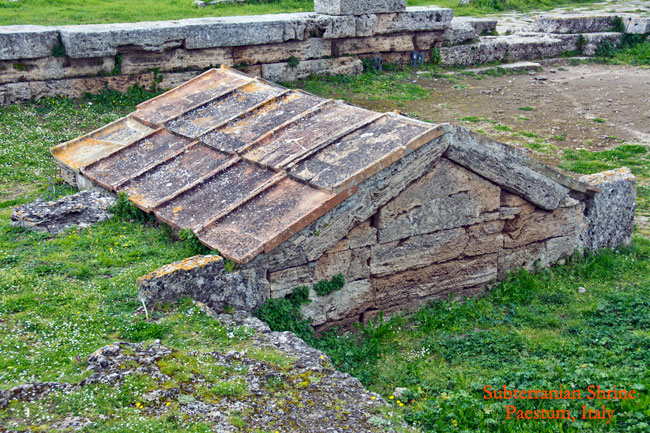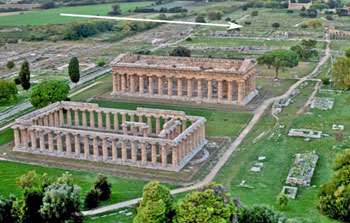
The Underground Shrine at Paestum (Poseidonia)
Poseidonia was a ‘second-generation’ Greek colony, founded by political refugees from Sybaris (an earlier Greek colony) some time around 600 BC. The location they chose was at  the southern end of the Bay of Salerno, south of Naples, on the Campanian coast.
the southern end of the Bay of Salerno, south of Naples, on the Campanian coast.
The new settlement was quite a success—the land was fertile and very productive, and it was nicely situated on the sea-lanes leading to the metal-rich land of Etruria. The remains of the Greek polis are impressive and include some of the best-preserved classical temples, such as the pair dedicated to the goddess Hera (left) to be found anywhere in the Mediterranean world today.
The Underground Shrine was discovered in 1954 in the area between the Forum and the Temple of Athena. It was found undisturbed, with its contents intact beneath a mound of earth (tumulus). Its form was that of a small Greek shrine, typical of the period, known as an aedicula— a rectangular, gable roofed structure built of stone blocks. This particular one was usual in that it had a double roof—a layer of stone tiles overlaid by another of terracotta— and because there were no openings of any kind.
Although aediculae were often used as tombs, there was no body nor any trace of a coffin in this one. In any case, burial within the confines of the polis was taboo to the ancient Greeks. Offerings were found inside— a row of six hydriai (water jars) and two bronze amphorae that were filled to the brim with a brown, sticky substance (honey perhaps?). There was also an Athenian black-figure amphora that had been repaired in antiquity— evidently it was seen as an object of some significance. In addition, there were five large iron spits, evidently used for roasting meat, resting on two stone blocks, and some scraps of leather and fabric.

Underground Shrine from the South
The painted amphora and the two bronze ones have been dated to the end of the 6th century BC, about the time that black-figure ware began to go out of fashion. The contents are typical of the sort of things that accompanied the deceased in a tomb. But in this instance, no trace of any human remains were found and, in any case, there was a strong taboo in the Classical world against burial within the city limits. A sherd of pottery was found nearby bearing the inscription “I am sacred to the Nymph”, which has led some to suppose that the building was a Nymphaeum dedicated to the spirits of the spring. Others have offered the suggestion that it was chthonic shrine to Kore (Persephone), daughter of Demeter, and queen of the underworld. The most likely interpretation, however, given that there is no entrance, it seems more likely that it was an Heröon—a cenotaph dedicated to the memory of the founder of the polis.

